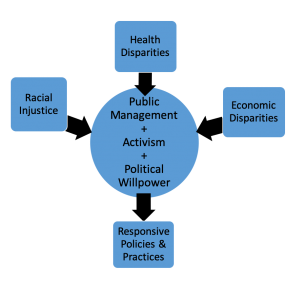Widgetized Section
Go to Admin » Appearance » Widgets » and move Gabfire Widget: Social into that MastheadOverlay zone
Public Service and the Responsibility for Action
The views expressed are those of the author and do not necessarily reflect the views of ASPA as an organization.
By Hillary J. Knepper
June 13, 2020
Nathan Teklemariam said it best at the end of his recent compelling article, “What are we doing wrong?” This is the right question. Those of us in public service are stepping back and reflecting on this. We’re seeking solutions that will finally, this time, be effective and widespread. The social and political intersectionality where Americans find themselves in the spring of 2020 may be delivering just the right confluence of tragedy and outrage necessary to affect revolutionary change across three key areas:
Unequal Health Outcomes
The United States’ vastly divergent health disparities have emerged front and center during the Covid-19 pandemic. In the United States, race is emerging as a key determinant for COVID-19 vulnerability, with black patients representing about 92 deaths per 100,000 and LatinX patients accounting for about 74 deaths per 100,000. These compare to the death rate of white patients, which is about 45 per 100,000.
Unjust Law Enforcement Experiences
Law enforcement treatment of African Americans evidences a deeply unjust system. Code Switch, a racial justice podcast on National Public Radio, recently aired A Decade of Watching Black People Die. It has been eight years since the murder of Trayvon Martin and the acquittal of George Zimmerman sparked Alicia Garza, Patrisse Cullors and Opal Tometi to found Black Lives Matter. We’re headed for real change, as seen in the City of Minneapolis, where city council members voted to disband their police department and rebuild. The use of body cameras, dash cams, cellphone videos and social media, have galvanized large demonstrations for justice in every state and in many countries around the world.
A Bifurcated Economy
When the economy falters, the repercussions and suffering are unequally distributed. Economic downturns are another opportunity for identifying pervasive unjust societal disadvantages in which black Americans are consistently disproportionately and adversely affected. This disparity is particularly crucial when considering that minorities face pervasive discrimination even among those organizations that “value disparity.”
Clearly, critical public administration failures have contributed to this long-standing trio of inequality. Yet, tragedy spurs action and society rises in protest, building momentum across the globe. So, now we march to voice our discontent; we march to make sure our voices are heard; but marching alone is not going to accomplish the change we need. It will take public administrators who are dedicated and creative to right society’s wrongs both in policy and in practice. Figure 1 models the Change Model for Public Management, Activism & Political Willpower.

Figure 1: Change Model for Public Management, Activism & Political Willpower
To paraphrase a recent post by Lawrence O’Donnell on Twitter, it isn’t your training in your field that is going to make the difference. It’s, “Your life training,” before you enter the workforce that will determine the type of person you are. This is essential to understanding who moves into public administration work.
As an educator in an urban MPA program for nearly 10 years, my program is well-represented by a diverse student body. African American students represent 28%-37%, LatinX students represent about 10%-13%, international students are about 20% and white students are about 24%-29% of the student body. I know that respect and inclusion are important factors in our classrooms. As the mother of African American sons, I feel anger and fear every day about what inclusion, full representation, justice, equity and opportunity mean for them as they grow into adults.
Consequently, as public administrators and educators of public administrators, core public service values such as integrity, transparency, accountability, professionalism and leadership are instilled in us from the very beginning. But throughout this time, we’ve also struggled with serving various administrations and their priorities, beliefs and agendas. How do we navigate these challenging contradictions? Resilience. Emotional Intelligence. Persistence. Alliance building. Activism and advocacy. And identifying alternate paths to doing the right thing. Pulling together in times of challenge. Putting aside petty and critical conflicts to address something as important as social justice—whether it is in healthcare, economic prosperity or racial justice in law enforcement. Lived experiences may vary in society, but everyone suffers and society is greatly diminished when inequity and injustice continue to prevail.
The incomparable Ida B. Wells, late 19th century civil rights activist and co-founder of the NAACP once noted, “The way to right wrongs is to turn the light of truth upon them.” Today, the light is shining in the darkness of injustice and inequity. Mobile devices capture devastating acts of cruelty and violence by public servants. Social science research illustrates disparities in health and economic opportunity. So today, I am calling on all public managers, scholars and educators to speak power to truth. I’m calling on all of us to educate, hire and elect individuals who have the resilience and drive to step forward and make the right choices. Change is within reach and it involves a coalescing around justice, equity and opportunity. We have the power to bring together public management and activism to generate the necessary political will power and the public administration infrastructure to create and sustain real change. Together we will change our world. Enough is enough. It is up to us.
Author: Dr. Hillary J. Knepper, MPA, Associate Professor, Interim Associate Provost for Academic Affairs, Pace University: [email protected]. She has over 20 years’ administrative experience as a practitioner in the public and nonprofit sectors prior to her work in academia. Her most recent work appears in Public Administration Review, Teaching Public Administration, the Journal of Public Affairs Education, Public Integrity, and Public Administration Quarterly. She is the co-editor of the Journal of Health & Human Services Administration.


Yari
June 16, 2020 at 2:23 pm
Great article!